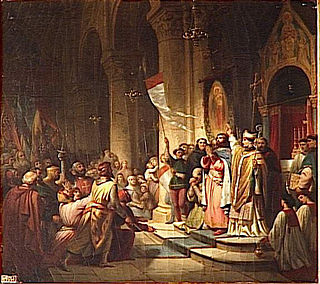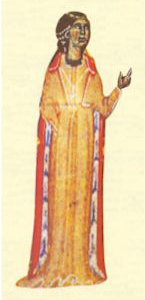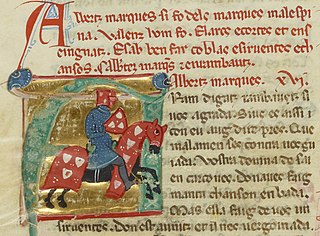Related Research Articles

Boniface I, usually known as Boniface of Montferrat, was the ninth Marquis of Montferrat, a leader of the Fourth Crusade (1201–04) and the king of Thessalonica.

Raimbaut de Vaqueiras or Vaqueyras was a Provençal troubadour and, later in his life, knight. His life was spent mainly in Italian courts until 1203, when he joined the Fourth Crusade. His writings, particularly the so-called Epic Letter, form an important commentary on the politics of the Latin Empire in its earliest years. Vaqueiras's works include a multilingual poem, Eras quan vey verdeyar where he used French, Tuscan, Galician-Portuguese and Gascon, together with his own Provençal.
The descort was a form and genre of Old Occitan lyric poetry used by troubadours. It was heavily discordant in verse form and/or feeling and often used to express disagreement. It was possibly invented by Garin d'Apchier when he wrote Quan foill'e flors reverdezis ; the invention is credited to him by a vida, and these are unreliable. Gautier de Dargies imported the descort into Old French and wrote and composed three.
The sirventes or serventes, sometimes translated as "service song", was a genre of Old Occitan lyric poetry practiced by the troubadours.
A tenso is a style of troubadour song. It takes the form of a debate in which each voice defends a position; common topics relate to love or ethics. Usually, the tenso is written by two different poets, but several examples exist in which one of the parties is imaginary, including God, the poet's horse or his cloak. Closely related, and sometimes overlapping, genres include:
André de France or André de Paris is an Old French romance, written in the 12th century, whose text is now lost. The eponymous hero was in love with a queen, and eventually died of love.

The Comtessa de Dia, possibly named Beatritz or Isoarda, was a trobairitz.

Aimeric de Belenoi was a Gascon troubadour. At least fifteen of his songs survived. Seven others were attributed to him in some medieval manuscripts.

Albert Malaspina (1160/1165–1206/1212), called Alberto Moro and lo marches putanier, was a member of the illustrious Malaspina family. He was a noted troubadour and patron of troubadours. Albert disputes with Peire de la Caravana the position of earliest native Italian troubadour.
Matieu de Caersi, Caerci, or Querci was a troubadour from the Quercy. According to the rubric accompanying his only song in troubadour manuscript C, he was Mayestre Matieus de Caersi, that is, a Master of Arts from Quercy, possibly Cahors. He is not to be identified with the Matheus who composed a tenso with Bertram de Gordon in 1212.
William I of Baux was the Prince of Orange from 1182 until his death. He was an important Provençal nobleman.
There were three troubadours named Isarn or Izarn, and who are difficult to distinguish completely today. The first has no surname and composed two partimens with Rofian around 1240. He has been confounded with the inquisitor Isarn.

A torneyamen or certamen was a lyric genre of the troubadours of the thirteenth century. Closely related to the tenso, a debate between two poets, and the partimen, a question posed by one poet and another's response, the torneyamen took place between several poets, originally usually three. The first three-way tenso was initiated by Raimbaut de Vaqueiras with Ademar de Peiteus and Perdigon. These wider tensos only became known as torneyamens later. A tenso or partimen that was submitted to another troubadour for adjudication may have a poetic jutjamen (judgement) attached to it and so may be considered as a torneyamen between three. The torneyamen, like the related debate forms, was probably especially common at contests, such as floral games and puys. Many such tensos and partimens come with attached jutjamens rendered in verse, as in the example Senyer Bernatz, dues puncelhas say cited below.
Raimbaut is a given name. Notable people with the name include:
Rostanh or Rostaing Berenguier de Marselha was an early fourteenth-century troubadour and Hospitaller from Marseille. He was a friend of the Grand Master Folco del Vilaret. The earliest biographical notice we have about Rostanh is the brief but unreliable biography in Jean de Nostredame. He is one of only three known troubadours to compose estampidas, the others being Raimbaut de Vaqueiras and Cerverí de Girona. Rostanh composed only one: La dousa paria. His songs are preserved in the manuscript called "Giraud", where the first one is a long canso in honour of his patron Folco.
Duran Sartor de Paernas or Duran Sartre de Carpentras was a Provençal troubadour from Pernes near Carpentras. The nickname sartor means "tailor". Two sirventes have been attributed to him, both reflect opposition to the royal crusade in Occitania: "Vil sirventes leugier e venassal" was written towards 1210, certainly before 1220, and "En talent ai qu'un sirventes encoc," which was written in 1242, during the Saintonge War. Although Duran criticises the crusade against alleged heretics, he encourages further efforts at crusading against Muslims.
Adémar II de Poitiers, known in Old Occitan as Ademar or Aimeric de Peiteus, was the count of Valentinois and de facto ruler of Diois from 1188 or 1189 until 1230. He was the son of Count Guillaume and grandson of Count Adémar I. He married Philippa, daughter of Guillaume-Jourdain, the lord of Fay, and Météline de Clérieu. The Finnish scholar Aimo Sakari hypothesised that Philippa of Fay was the famous trobairitz known as the Comtessa de Dia, and that the friend (amic) mentioned by the Comtessa in her poems was the troubadour Raimbaut de Vaqueiras. Around 1195–96, Adémar himself participated in a three-way torneyamen with Raimbaut de Vaqueiras and Perdigon.
The devinalh, was a genre of Old Occitan lyric poetry practiced by some troubadours. It takes the form of a riddle, or series of riddles or cryptograms and is, if read literally, mostly nonsensical. Known practitioners include Guilhen de Peiteu, Raimbaut of Orange, Giraut de Bornelh, Guilhem Ademar, Guilhem de Berguedan and Raimbaut de Vaqueiras.
12th century in music – 13th century in music – 1300s in music
References
- ↑ de Vaqueiras, Raimbaut. "Canso 14 (Ja non cujei vezer)". Raimbaut de Vaqueiras: Complete Works. Retrieved 2009-09-13.
- ↑ Lewent, Kurt (Feb 1946). "The troubadours and the romance of 'Jaufre'". Modern Philology. 43 (3). The University of Chicago Press: 153–169. doi:10.1086/388685. JSTOR 434704. S2CID 162238781.